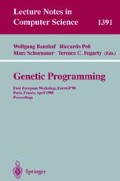Abstract
Our purpose is to enhance performance of Genetic Programming (GP) search. For this, we have been develop a homogeneous system allowing to construct simultaneously a solution and sub-parts of it within a GP framework. This problem is a crucial point in GP research lately since this is intimately linked with building blocks existence problem. Thus, in this paper, we present an “on-going” work concerning DL GP — Dynamic Lattice Genetic Programming— a new GP system to evolve shared specific modules using a hierarchical cooperative coevolution paradigm. This scheme attempts to improve efficiency of GP by taking one’s inspiration of organization of natural entities, especially the emergence of complexity. In particular, DL GP does not require heuristic knowledge. Different credit assignment strategies are presented to compute modules fitness.
DLGP approach attempts to reduce the global depth of a tree-solution and avoids multiple searches of the same sub-components. Moreover modules induction improves “readability” of GP outputs. In particular, local evolutionary process is applied on the different set of subroutines in order to do converged each population toward a specific ability which remains at disposal of higher level subroutines. Problem decomposition and sub-tasks distribution is emergent through the lattice.
Preview
Unable to display preview. Download preview PDF.
References
P. J. Angeline and J. B. Pollack. The evolutionary induction of subroutines. In Proceedings of the Fourteenth Annual Conference of the Cognitive Science Society, Bloomington, Indiana, USA, 1992. Lawrence Erlbaum.
P. J. Angeline and J. B. Pollack. Coevolving high-level representations. July Technical report 92-PA-COEVOLVE, Laboratory for Artificial Intelligence. The Ohio State University, 1993.
F. Gruau. Neural Network Synthesis using Cellular Encoding and the Genetic Algorithm. PhD thesis, Laboratoire de l’Informatique du Parallélisme, Ecole Normale Supérieure de Lyon, France, 1994.
John R. Koza. Genetic Programming: On the Programming of Computers by Natural Selection. MIT Press, Cambridge, MA, USA, 1992.
John R. Koza. Genetic Programming II: Automatic Discovery of Reusable Programs. MIT Press, Cambridge Massachusetts, May 1994.
J. P. Rosca and D. H. Ballard. Learning by adapting representations in genetic programming. In Proceedings of the 1994 IEEE World Congress on Computational Intelligence, Orlando, Florida, USA, Orlando, Florida, USA, 27–29 June 1994. IEEE Press.
Justinian Rosca. Towards automatic discovery of building blocks in genetic programming. In E. V. Siegel and J. R. Koza, editors, Working Notes for the AAAI Symposium on Genetic Programming, pages 78–85, MIT, Cambridge, MA, USA, 10–12 November 1995. AAAI.
Marc Schoenauer, Bertrand Lamy, and Francois Jouve. Identification of mechanical behaviour by genetic programming part II: Energy formulation. Technical report, Ecole Polytechnique, 91128 Palaiseau, France, 1995.
Lee Spector. Evolving control structures with automatically defined macros. In E. V. Siegel and J. R. Koza, editors, Working Notes for the AAAI Symposium on Genetic Programming, pages 99–105, MIT, Cambridge, MA, USA, 10–12 November 1995. AAAI.
Lee Spector and Kilian Stoffel. Ontogenetic programming. In John R. Koza, David E. Goldberg, David B. Fogel, and Rick L. Riolo, editors, Genetic Programming 1996: Proceedings of the First Annual Conference, pages 394–399, Stanford University, CA, USA, 28–31 July 1996. MIT Press.
Marc Schoenauer, Michele Sebag, Francois Jouve, Bertrand Lamy, and Habibou Maitournam. Evolutionary identification of macro-mechanical models. In Peter J. Angeline and K. E. Kinnear, Jr., editors, Advances in Genetic Programming 2, chapter 23, pages 467–488. MIT Press, Cambridge, MA, USA, 1996.
Moshe Sipper, Eduardo Sanchez, Daniel Mange, Marco Tomassini, Andres Perez-Uribe, and Andre Stauffer. The POE model of bio-inspired hardware systems: A short introduction. In John R. Koza, Kalyanmoy Deb, Marco Dorigo, David B. Fogel, Max Garzon, Hitoshi Iba, and Rick L. Riolo, editors, Genetic Programming 1997: Proceedings of the Second Annual Conference, page 510, Stanford University, CA, USA, 13–16 July 1997. Morgan Kaufmann.
Astro Teller and Manuela Veloso. Neural programming and an internal reinforcement policy. In John R. Koza, editor, Late Breaking Papers at the Genetic Programming 1996 Conference Stanford University July 28–31, 1996, pages 186–192, Stanford University, CA, USA, 28–31 July 1996. Stanford Bookstore.
Astro Teller and Manuela Veloso. PADO: A new learning architecture for object recognition. In Katsushi Ikeuchi and Manuela Veloso, editors, Symbolic Visual Learning, pages 81–116. Oxford University Press, 1996.
Author information
Authors and Affiliations
Editor information
Rights and permissions
Copyright information
© 1998 Springer-Verlag Berlin Heidelberg
About this paper
Cite this paper
Racine, A., Schoenauer, M., Dague, P. (1998). A dynamic lattice to envolve hierarchically shared subroutines. In: Banzhaf, W., Poli, R., Schoenauer, M., Fogarty, T.C. (eds) Genetic Programming. EuroGP 1998. Lecture Notes in Computer Science, vol 1391. Springer, Berlin, Heidelberg. https://doi.org/10.1007/BFb0055941
Download citation
DOI: https://doi.org/10.1007/BFb0055941
Published:
Publisher Name: Springer, Berlin, Heidelberg
Print ISBN: 978-3-540-64360-9
Online ISBN: 978-3-540-69758-9
eBook Packages: Springer Book Archive

